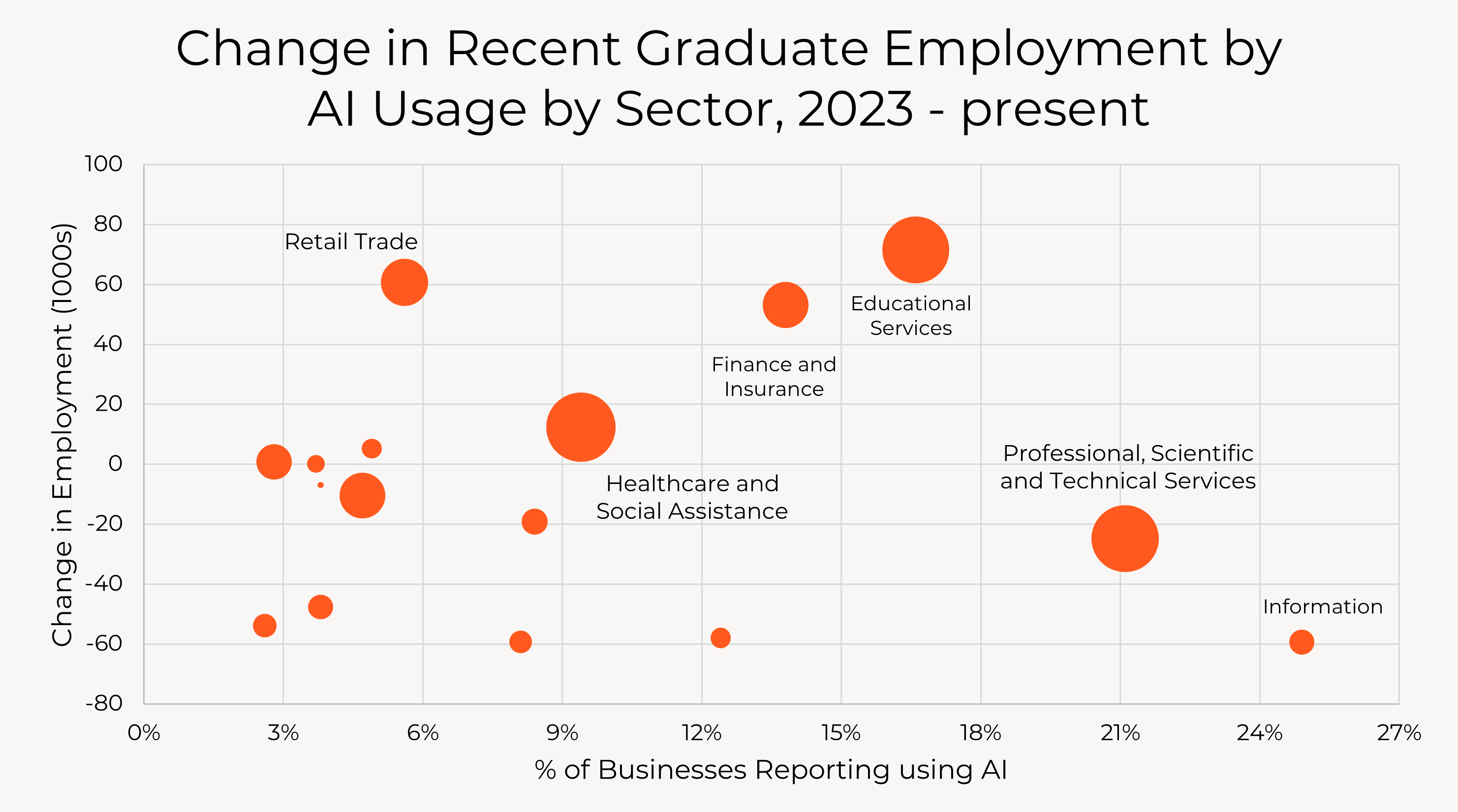This is a guest post by Will Raderman.
For decades, recent college graduates (defined as those aged 22-27 with a Bachelor’s degree) have enjoyed lower unemployment rates than the rest of the working age population. That’s no longer true; since late 2018, the unemployment rate of recent college graduates has generally been higher than the rest of the labor force. In recent months, the unemployment rate of recent college graduates has been two percentage points higher than the overall unemployment rate.
A popular narrative has emerged that the rise of generative AI tools like ChatGPT and Claude is to blame for the high unemployment of recent college graduates. Upon a closer look, the evidence for this claim is thin. The relative deterioration in labor market outcomes for recent graduates is part of a longer trend that predates generative AI. Majors with higher exposure to generative AI have not necessarily faced worse unemployment rates relative to pre-pandemic, and employment shifts of recent graduates in major sectors of the economy do not correlate with reported business sector use of AI. Basic labor supply and demand dynamics and broader macroeconomic trends are more compelling explanations.
The Timing Doesn’t Line Up
It’s worth remembering that generative AI is a relatively recent invention. ChatGPT, the first widely-used large language model, was released in November 2022. It has taken longer for these products to become more widely-used in the workplace. In the Census Business Trends and Outlook Survey (BTOS), just 3.7% of firms reported using AI in September 2023 (the earliest edition of the survey).

By contrast, labor market outcomes for recent graduates have been deteriorating (relative to other workers) for years before the widespread adoption of generative AI. The monthly Current Population Survey (CPS) data show that recent graduates held a worse unemployment rate than the rest of the working-age population in the lead up to the pandemic and once again in early 2021. This discrepancy grew wider from that point onward.

Recent college graduates' employment edge began to erode before ChatGPT as well. There has been a noticeable downward trend since the 2010s. After the pandemic, the difference between the employment rate of recent graduates and all workers peaked at 12.1% in the summer of 2021 and proceeded to fall 0.6 percentage points by the time ChatGPT was released. This gap shrunk another percentage point over the subsequent year, when businesses still reported minor usage of AI.

The fact that recent college graduate labor market outcomes have been deteriorating (relative to the other workers) for years poses a simple problem for the generative AI story, and suggests that other longer-term factors are responsible.
Unemployment Doesn’t Stand Out For Majors With Higher AI Exposure
If AI is to blame for the woes of recent college graduates, then we should expect to see college majors with the highest exposure to AI experiencing greater increases in unemployment. However, the majors most exposed to AI (many in STEM fields) are not consistently the worst-performing majors in the labor market.
Timmerman (2025) combines National Survey of College Graduates data and previously-developed occupational exposure scores to determine which college majors are the most exposed to generative AI. According to Timmerman, “Mathematics and Computer Science-related fields and Engineering and Technology-related fields may be the most affected by generative AI.”
Nevertheless, majors with higher AI exposure have experienced a range of outcomes, and some are even experiencing even lower unemployment rates than before the pandemic (using the latest available NY Fed data through 2023). This runs contrary to some of the recent media coverage, which has painted a more dire picture for STEM. Below, I plot the change in unemployment rate by major between 2017-2018 and 2023, with high-AI-exposure majors bolded.

While computer science, computer engineering, and chemistry fields have seen higher unemployment rates, this experience is not widely true of high-exposure majors. Mathematics, accounting, and business analytics majors—all of which are high-AI-exposure majors in Timmerman (2025)—are currently enjoying lower unemployment rates than pre-pandemic. Additionally, four of the ten majors with the biggest drop in unemployment relative to pre-Covid were in engineering, which Timmerman (2025) finds have high exposure to image generation technologies. In short, employment outcomes by major do not appear to be correlated with high exposure to AI technology.
Sectoral Changes In Recent Graduate Employment Are Not Correlated With AI Usage
Finally, the sectoral employment trends of recent graduates do not support the AI hypothesis. Recent graduate employment growth across AI-intensive sectors has kept pace with that of non-intensive sectors, and the employment shifts of individual sectors do not correlate with the reported use of AI by businesses.
To identify sectors that are the most AI-intensive, I again use the BTOS, which reports the fraction of firms in each sector that reported using AI in production. I define AI-intensive sectors as those where over 10% of employers reported using AI in production in 2025, between late February and May (Information, Finance and Insurance, Real Estate and Leasing, Professional, Scientific, and Technical Services, Management of Companies and Enterprises, and Educational Services). All other sectors are considered to not be AI-intensive, because under 10% of employers reported use of AI to produce their goods and services.
It is hard to see any effect of AI when comparing the trajectory of employment in AI-intensive and non-intensive sectors. Below, I plot recent college graduate employment in high- and low- AI-intensive sectors relative to their respective levels in November 2022, the month when ChatGPT was first released. Over the four years prior to ChatGPT, recent graduate employment in AI-intensive sectors actually *declined* relative to recent graduate employment in non-intensive sectors. But, since the release of ChatGPT, recent graduate employment in AI-intensive sectors has kept pace with non-intensive sectors on net. If anything, recent graduate employment has performed a bit better of late (relative to the most recent pre-generative AI trend) in sectors where AI usage is more prevalent.

Sector-specific trends over the past two years point against the popular AI hypothesis as well. Businesses in the Professional, Scientific, and Technical Services and Information sectors may have had greater uptake of AI alongside a decline in recent graduate employment from 2023 to present, but these sectors aren’t the whole story. For one, recent graduates have seen increased employment in other sectors with higher reported AI usage, such as Educational Services and Finance and Insurance. Second, a collection of sectors with low AI-usage have also experienced notable employment reductions amongst recent graduates. There is no clear correlation between either the change in uptake of AI between 2023 and 2025 (or the level of uptake in AI in 2025) and the change in sectoral employment for recent college graduates.


There Are Other Explanations For The Rising Unemployment Of Recent College Graduates
Generative AI may make it harder for college-educated professionals to find work over time in specific white collar industries. However, AI is not the best explanation why recent graduates have been struggling more to find jobs. Although computer science majors are in rough shape, many STEM and business majors have seen lower unemployment than pre-pandemic. The sectors with worse labor participation from recent graduates are also not correlated with higher AI exposure. Even if generative AI is driving recent graduate employment declines in Information and Professional, Scientific, and Technical Services, other sectors with high AI usage have seen strong growth in the employment of recent graduates. Furthermore, the biggest declines in recent graduate employment are not concentrated in the high AI-use sectors.
If AI does not explain the rise in unemployment for recent graduates, what does? There are a number of alternate explanations. One is simple supply and demand: there is a greater supply of recent graduates now than in past decades, including a notable increase in the number of computer science graduates. The job prospects of recent college graduates may have gotten worse, in part, because employers have more to choose from.
When looking at the most recent rise in recent graduate unemployment, the broader macroeconomic environment may be playing a role. The overall hiring rate has slowed, which could be making it more difficult for recent graduates entering the workforce. The uptick in competition for lower-income workers has disproportionately benefited young non-college workers. Comparatively stronger labor market tightness among this population could help explain why recent graduates have seen their unemployment rate rise above that of all workers.
A related explanation that also matches the earlier timeline for labor market weakness is the “tech-cession” we saw in 2022, pre-dating the breakthroughs in large language models. As a result of rapid interest rate hikes depressing valuations for more technology firms both large and small, established and speculative, firms likely responded with a mix of layoffs and much weaker gross hiring rates.
AI may be a hot topic, but I don’t see strong evidence that it’s responsible for the weaker labor market for recent college graduates. It’s possible that this will change in the future, but for now it’s more likely that longer-term structural changes to the labor market and broader labor dynamics are the relevant causal factors.
